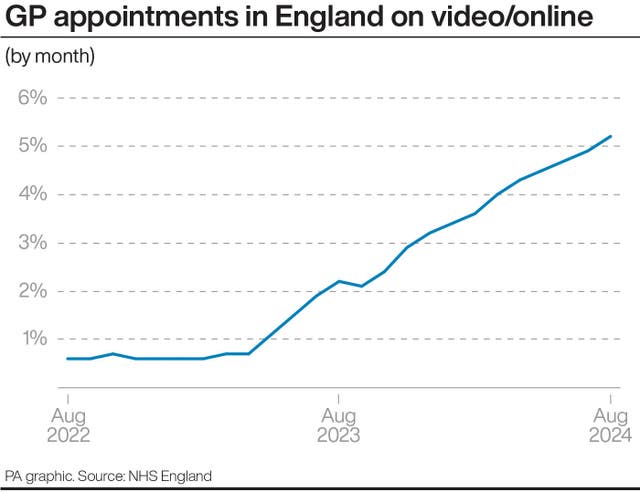One in 20 GP appointments performed online or by video in August
The figure has been rising steadily for much of the past year-and-a-half.

One in 20 GP appointments in England in August were carried out by video or online – the highest proportion since current records began.
Doctors said remote consultations are “often more convenient” for patients, but they work to ensure requests for face-to-face appointments are respected.
They also claim the “issue is not about online appointments – it’s about having enough GPs to begin with”.
The proportion of GP appointments delivered by video or online has been rising steadily for much of the past year-and-a-half, passing 1% in May 2023, 2% in August and 3% in December.
It hit 4% in March 2024 and stood at 5.2% in August: the first time it has been above 5%, according to analysis of NHS England data by the PA news agency.

The increase in appointments done by video or online has coincided with a fall in the proportion of face-to-face consultations.
Some 70.8% of GP appointments were carried out in person in October 2023, but this had dropped to 64.8% by August this year – the lowest figure since June 2022.
The proportion of appointments carried out over the phone stood at 26.1% in August and has held steady at around 26% for much of the past 12 months.
Comparable data for GP appointments in England begins in March 2022.
Dr Rachel Ward, a GP and member of the Rebuild General Practice campaign group, said: “GPs are seeing more patients than ever before – providing 27.6 million total appointments in August alone.
“We have been ringing the alarm bell for years, saying that the profession needs to retain its GPs, receive fairer funding, and have greater autonomy.
“Where we can offer online appointments – and importantly, when patients themselves want them – we will do so. This is often more convenient for our patients and allows us to see all patients more quickly and equally as effectively.
“For those patients who need or request an in-person appointment, we ensure that this is respected and that patients receive the care they want and deserve.
“The crux of the issue is not about online appointments – it’s about having enough GPs to begin with.”
Professor Kamila Hawthorne, chair of the Royal College of GPs (RCGPs), also backed a “mixed method approach”.
“The college supports a mixed-method approach to delivering care and services in general practice, whereby practices can provide both in-person and remote appointments,” she said.
“This should be a decision made between patient and clinician.
“Many patients prefer the convenience and flexibility that remote consultations – whether delivered over the phone or via video – can offer, and evidence has also shown that in the vast majority of cases, remote care is safe.
“However, we also know that many patients prefer to access care in-person and this is how the vast majority of appointments in general practice are being carried out.
“In many cases, GPs might initially consult with a patient remotely, and then ask them to come into the practice if it’s necessary to see them in person.”
However, Prof Hawthorne stressed the importance of GPs having “robust and up-to-date” technology to deliver appointments online.
“What’s key is that when GPs are consulting with their patients remotely, they have access to the robust and up to date hardware and software that allows them to do so safely and effectively,” she added.
“This is one reason why the RCGP is calling for significant investment to improve GP practice infrastructure which, crucially, includes our digital and IT systems.”
A Department of Health and Social Care spokesperson said: “Patients who prefer a face-to-face appointment should have one and we are also committed to shifting care from analogue to digital, which includes offering patients digital appointments when and where they need one.
“We will get primary care back on its feet, shifting the focus out of hospitals and into the community, fixing the front door of the NHS and ending the misery of people unable to get a GP appointment.”





